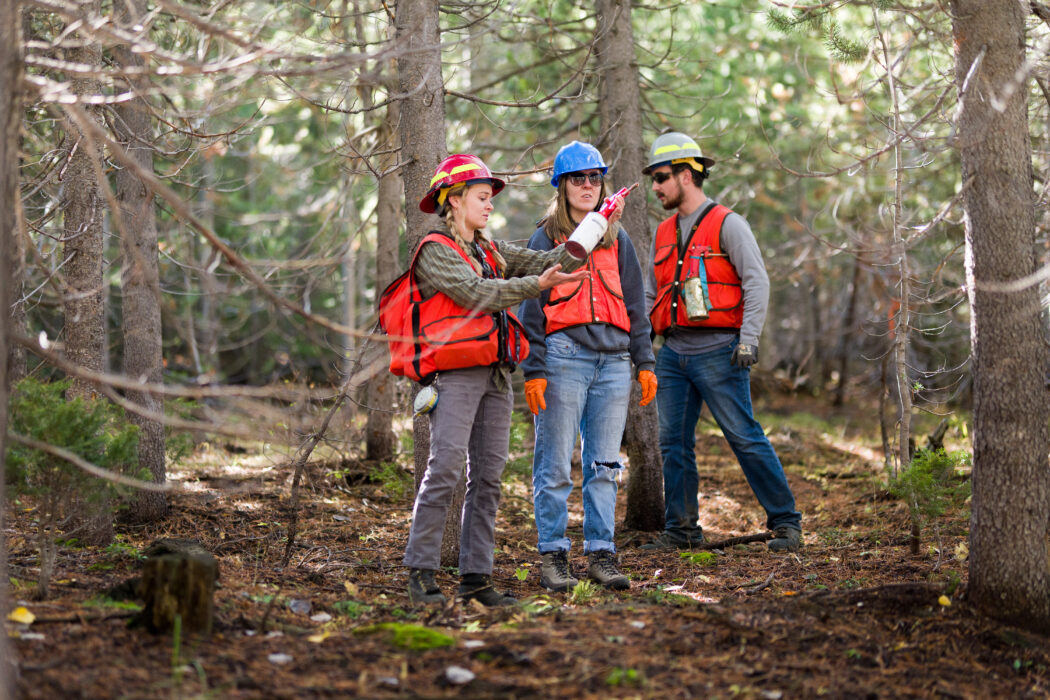T.W. Daniels Experimental Forest: USU’s slice of nature
A 45-minute drive from Utah State University is a patch of national forest known as the T.W. Daniel Experimental Forest. It is located on Sinks Road, south of Bear River Summit. The forest can also be found via a short trail up Little Bear Canyon.
Ryan Jess is the manager for the forest’s dendrochronology laboratory, which tracks and dates tree rings.
“The first time I went to the School Forest I was surprised by how close the forest is to campus, and by how large the School Forest feels,” Jess wrote in an email to The Utah Statesman.
Known colloquially as the School Forest, this four-square-mile piece of land is a significant part of USU’s history.
Before it became Utah State University, the Utah State Agricultural College purchased a square mile of Cache National Forest in 1936. At some point between then and the 40s, the college developed a memorandum of understanding with the U.S. Forest Service to operate within that section, plus three more adjacent sections, for educational use.
Over the decades, this living laboratory has undergone transformational phases, from its origins as the School Forest to a hub for research, ecological conservation and forestry education through the S.J. & Jessie E. Quinney College of Natural Resources.
In 1946, Ted Daniel was hired by Utah State Agricultural College to work as a silviculturist, or someone who works to establish forest health, and the next year, started a summer camp for forestry students.
“They started measuring cones, tracking wildlife, quantifying how much timber was on the plot,” said Justin DeRose, assistant professor of wildland resources.
Many of the forest’s research endeavors gained momentum in the late 1990s, with a project led by Fred Baker and Jim Long demonstrating ecosystem management approaches that mimicked natural disturbance.
The forest continued to be a focal point for scientific exploration with projects addressing topics such as goshawk habitat, landscape-scale disturbance processes, aspen decline and lynx habitat.
DeRose has been involved with the forest since his undergraduate in the late 90s.
“Since then, I’ve spent a lot of time in the forest doing the same thing: teaching students, demonstrating forestry and working on research projects,” DeRose said.
The forest witnessed a diverse range of projects in the early 2000s, from addressing drought and water resources to uneven-aged silviculture for Engelmann spruce. The installation of monitoring equipment, data loggers and towers marked a technological leap, enhancing the forest’s capabilities for long-term data collection.
“Because it’s an experimental forest, it gives leeway to do management activity under categorical exclusion in the NEPA [National Environmental Policy Act] process,” DeRose said.
This means USU or the Forest Service can do less common treatment to help teach or demonstrate something to students.
The forest has continued its evolution in recent years. DeRose installed several large, fixed-area monitoring plots in 2019, and in 2022, biology professor Robert Schaeffer began a pollinator habitat study, extending the forest’s reach outside of QCNR.
Demonstrations and outreach on subjects such as silviculture and ecosystem management occur every year during the summer months in the form of field trips.
Ellen Orlemann, a forestry major, spent time in the School Forest with the Forestry Club. The club has a fundraiser each fall where they harvest firewood to sell.
“It can be a really good experience for people to try their hand using a chainsaw for the first time, which is a super big resume booster,” Orlemann said.
Many natural resource students are required to take an intro-level class called WILD 2400, which includes field trips up to the forest. Orlemann said this has a direct effect on whether or not people stick with the program.
“Having fun doing things in the outdoors definitely makes people stick with it more,” Orlemann said.
Spending time in the forest and getting hands-on learning experience can be beneficial educationally.
“It makes what we’re doing real,” Orlemann said. “Being able to take people out in the forest and give them real-world experience brings a lot of people in.”
Opportunities to go on field trips to the forest help foster a sense of community among the students and faculty.
“You go up not really knowing any of the people you’re going up with, but then when you come back down, you’re good friends,” Orlemann said.
Jess has seen the way students benefit since he began working as the lab manager in 2017.
“I learn best by doing, and I think a lot of students appreciate being able to practice the skills and principles they have learned in a real-life setting,” Jess wrote. “The School Forest is a laboratory not only for research, but as a place to gain useful experience students can use later on in their careers.”
Although the forest exists as a learning vehicle for students studying natural resources, it’s accessible to anyone looking to hike, mountain bike, camp or stargaze.
“I would just encourage anyone who has the chance to go out there and to do it,” Orlemann said. “It’s really cool that USU owns a chunk of the Cache National Forest.”
The forest remains a testament to the enduring synergy between education, research and conservation, embodying a commitment to understanding and preserving the intricate balance of forest ecosystems.
“The forest is something that the chance to experience how principles you learn in the classroom really work in the complexity of a real ecosystem,” DeRose said.

